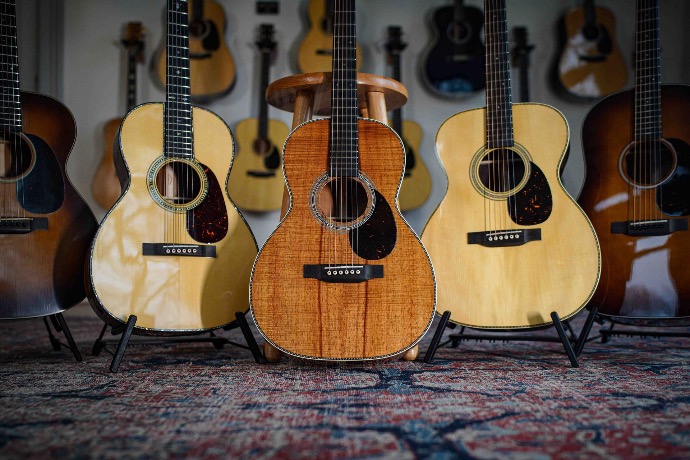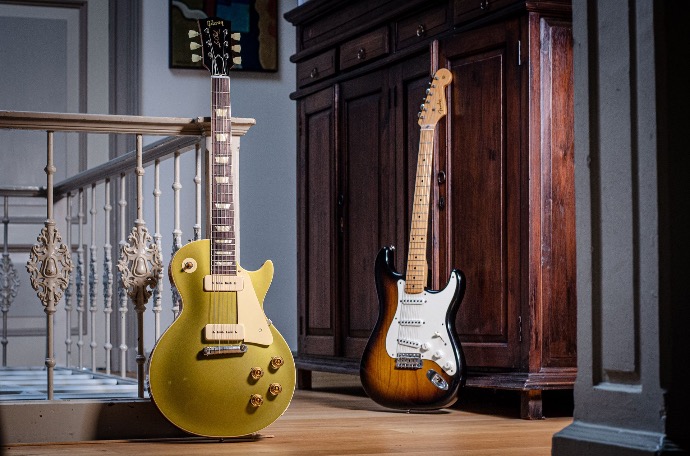Looking for your perfect guitar?
We help you step by step in our buying guides.
What is the scale length of a guitar?
Most people think that the scale length indicates the length of the neck of an electric or acoustic guitar. That is not entirely true, because the scale length does affect the length of the neck, but it actually indicates the length of the strings on a guitar, measured from the nut to the bridge.
But how do they measure that on an electric guitar, because then the strings have a difference in length due to the bridge adjustment, right?
In order to avoid confusion to determine the scale length, the string is measured from the nut to the 12th fret, which is a straight line and than you multiply that by two to get the scale length.
What is the difference between a short scale and a full scale guitar?
You can make a rough division between 'short scale' and 'full (or long) scale' guitars and than there are a lot of varieties.
A full scale guitar is pretty much the gold standard found on a Fender Strat- or Telecaster, on a Martin Dreadnought or OM and lots of other guitars and such a full scale has a length of 25.5 inches (65 centimetres)
A short scale guitar has a scale length of about 24.75 inches (63 centimetres) and you'll find these on a Gibson Les Paul or J45, for example, or on a Martin 000 model. Since most major luthiers are US-based, scale length is often given in inches, but on Spanish or classical guitars you'll see it in centimetres or millimetres. A ‘senorita’ or 7/8 model is then best compared to a short scale.
There are also lots of variants that are extra short, such as the popular Wee Lowden and Sheeran guitars with a scale length of 24 inches.
There are also guitars with an extra-long scale, such as baritone guitars, whose strings can be more than 10 centimetres longer than on a standard guitar.
Bass guitars (usually) have a scale length of 34 inches: a little over 86 centimeters.
Here is an overview of common acoustic and electric guitars with their scale length in inches and centimeters.
Electric guitars | Scale length in inches | Scale length in millimeters |
Fender Jaguar | 24" | 610 millimeter |
Gibson/Epiphone (most) | 24.75" | 628 millimeter |
PRS (most) & Eastman hollow body | 25" | 635 millimeter |
Fender (most) & PRS Silver Sky | 25.5" | 648 millimeter |
Ibanez (7-string) | 26.5" | 673 millimeter |
Baritone guitars | 27"-30" | 686-762 millimeter |
Bass guitars | 34" | 864 millimeter |
Acoustic guitars | Scale length in inches | Scale length in millimeters |
Sheeran/Lowden (W-model) | 24" | 610 millimeter |
Gibson (most) Martin 000/00/0 models | 24.75" | 628 millimeter |
Martin and most other dreadnought/OM models. Taylor Grand Auditorium | 25.5" | 648 millimeter |
Acoustic baritone guitars | 26.8"-30" | 680-762 millimeter |
Acoustic bass guitars | 34" | 863 millimeter |
What is a multiscale guitar?
A multiscale guitar is also called fan fretted, because the frets are not straight, but at an angle on the neck. That's because the thicker strings on these guitars are longer than the thin ones. This way you make the low notes even lower and the high notes higher and that gives guitar players a totally different way of expression themselves. Many metal guitarists have already discovered this, but on an acoustic guitar this really provides a unique experience and sound.
What is the best scale length for my guitar?
The best scale length does not exist, because it is very, very personal. But there are a number of things to consider when choosing the best scale length for your guitar. First: the feeling! Because the length of the strings determines how much tension is on them. The longer the string, the more tension. Some players like a full scale guitar for playing chords, strumming cowboy cords, but also beautiful, clear jazz-runs.
Other players are looking for an easier way to bend strings and that is where a short scale can really help, because there is less tension on the strings. Other players prefer a shorter neck, because the frets are slightly closer together and that comes in handy with some solos or if you have slightly smaller hands. And then there are players that appreciate a little more surface area as some extra workspace and will be tempted by a full scale guitar.
A few millimetres difference in scale length can give you a completely different playing feel, but there are also guitarists who switch from a full scale Stratocaster to a short scale Les Paul almost effortlessly, because it suits that particular song or guitar part better. It really is different for everyone, which is why it is good to know that the above list is not complete. Many luthiers (including Taylor and PRS) also make intermediate sizes that are slightly longer or shorter and may give you that ultimate guitar feel.
In this video Diane Ponzio explains what the scale length means for Martin guitars.
Another reason to look at the scale length is the sound of the guitar. Opinions are somewhat divided about volume: one says that full length guitars produce a louder sound, but that does not necessarily have to be the case. That increase in volume can also be caused by a different construction of the body. Longer strings do provide more bass notes and will give a different 'balance' in your guitartone.
Longer strings do provide more bass and thus a different ‘balance’ in tone. You can clearly hear this in the deeper-sounding baritone guitars with a longer scale length. Here, too, it's a matter of trying out what suits you best and you can always do so in our shop in Dedemsvaart, where, besides 1000 guitars, full scale coffee and short scale espresso are waiting for you!

